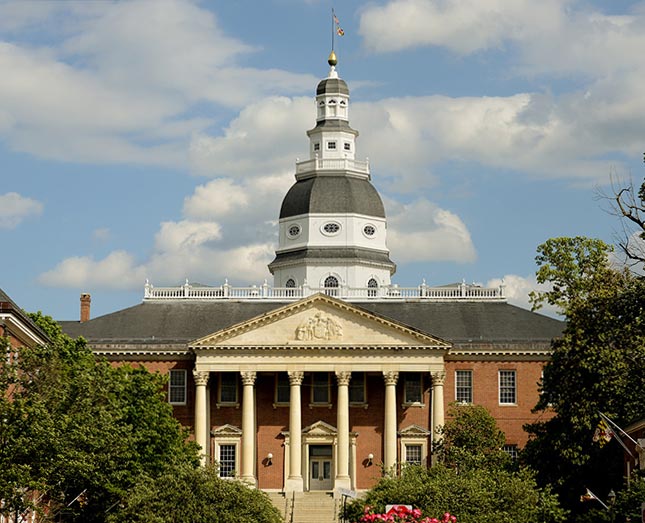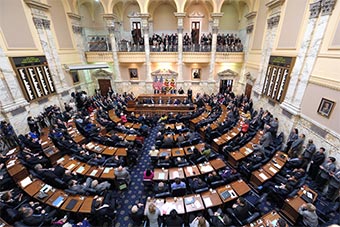EXECUTIVE BRANCH
The Executive Branch implements and enforces Maryland's laws and provides executive direction to government. It consists of various officers and agencies
authorized by the Maryland Constitution and State laws.

Constitutional Offices
Maryland's chief executive officer is the Governor, elected by the voters to a four-year term each even-numbered year that is not a
presidential election year. The Governor is responsible for ensuring that Maryland's laws are executed effectively; that appointments required by the Constitution
or by law are made; and that a budget is presented annually to the legislature. As commander in chief of the military, the Governor sees that the armed forces of
the State are able to meet any emergency. The Governor appoints judges to the State judiciary and may veto legislation passed by the Legislature. The Governor is
assisted by the Lieutenant Governor, who is elected on a joint ballot with the gubernatorial candidate. Duties of the Lieutenant Governor are limited to those
assigned by the Governor. The Governor and Lieutenant Governor each must be at least thirty years old and a resident and voter of Maryland for the five years
immediately preceding election.
Other statewide executive officers also are provided for in the Constitution. The Comptroller of Maryland superintends the fiscal affairs of the State. The State
Treasurer accounts for all deposits and disbursements to or from the State treasury. The Secretary of State attests to the Governor's signature on all public
documents and oversees all executive orders, commissions, and appointments. The Attorney General serves as legal counsel to the Governor, the Legislature, and all
State departments, boards, and most commissions. Voters elect the Comptroller and Attorney General. The State Treasurer is selected by joint ballot of both houses
of the General Assembly, and the Secretary of State is appointed by the Governor. Each of these executive officers serves a four-year term.
An important agency of the executive department is the Board of Public Works, composed of the Governor, the Comptroller of Maryland, and the State Treasurer. The
Board approves all sums expended through State loans, most capital improvements, and the sale, lease, or transfer of all real property owned by the State.

Departments
Between 1969 and 1972, the executive branch of government was reorganized to bring agencies with related functions together under a new
departmental structure. The General Assembly created twelve cabinet-level departments, encompassing nearly 250 separate governmental entities. In order of their
creation, the twelve departments were: Health and Mental Hygiene, Budget and Fiscal Planning, Natural Resources, State Planning, Personnel, General Services, Human
Resources, Public Safety and Correctional Services, Licensing and Regulation, Economic and Community Development, Transportation, and Agriculture. The State
Department of Education became a principal department in 1976, and in 1983, the Department of Employment and Training was created.
A second major reorganization of government was enacted by the General Assembly in 1987. The Department of Economic and Community Development, and the Department
of Employment and Training were abolished. Their functions were reorganized under the Department of Economic and Employment Development, and the Department of
Housing and Community Development. In the same year, the Department of the Environment was created to assume those environmental responsibilities previously
overseen by the Department of Health and Mental Hygiene, and the Department of Natural Resources. In 1989, the General Assembly transferred duties of the
Department of State Planning to other agencies and formed a new Department of Juvenile Services.
Governmental reorganization continued in the 1990s. The Maryland State Police became the Department of Maryland State Police in 1994, and the Department of State
Police in 1995. Also in 1995, the Division of Employment and Training transferred from the Department of Economic and Employment Development to the Department of
Licensing and Regulation. Restructured, the latter became the Department of Labor, Licensing, and Regulation. At the same time, the Department of Economic and
Employment Development reformed as the Department of Business and Economic Development, and the Department of Juvenile Services was renamed the Department of
Juvenile Justice. In 1996, the Department of Personnel was abolished. Its functions were assigned to the Department of Budget and Fiscal Planning, which reorganized
that year as the Department of Budget and Management. In 1998, the Office on Aging reformed as the Department of Aging; and in 1999, the Department of Veterans
Affairs was created.
Restructuring of Maryland government still continues. In 2000, the Office of Planning reorganized as the Department of Planning, and, in 2003, the Department of
Juvenile Justice resumed its earlier name of Department of Juvenile Services. From the Office for Individuals with Disabilities, the Department of Disabilities
formed in 2004. On July 1, 2008, information technology functions from the Department of Budget and Management organized into the Department of Information
Technology.
Now, within the executive branch are nineteen principal departments. Each, except for Education, is headed by a secretary, who serves at the pleasure of the
Governor and is appointed by the Governor with Senate consent. Each secretary carries out the Governor's policies pertaining to that department and is responsible
for the department's operation. The State Department of Education is headed by the State Board of Education, which appoints the State Superintendent of Schools to
direct the department.
Independent Agencies
Certain State agencies whose purpose or functions do not permit easy integration into one of the nineteen cabinet-level departments
have remained independent. Examples of such independent agencies include the State Department of Assessments and Taxation, the State Board of Elections, the Public
Service Commission, and the University System of Maryland.
Executive Commissions & Task Forces
Executive departments and independent agencies are augmented by special study commissions and task forces at the
discretion of the Governor, and the General Assembly.
